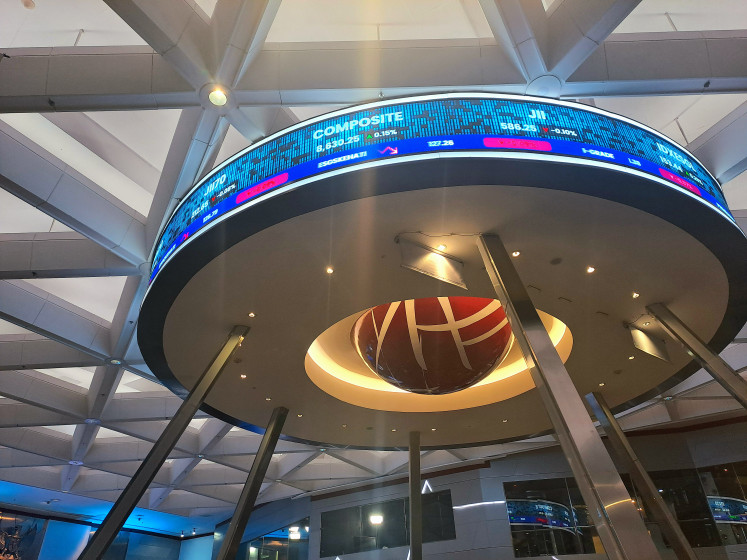Popular Reads
Top Results
Can't find what you're looking for?
View all search resultsPopular Reads
Top Results
Can't find what you're looking for?
View all search resultsBond market outlook: Stability through volatile times
High yields, stable macro conditions, pro-market policy support and solid institutional demand keep the domestic bond market relevant.
Change text size
Gift Premium Articles
to Anyone
 Minister of Finance Sri Mulyani Indrawati (center) accompanied by Deputy Ministers Thomas Djiwandono (second left) and Suahasil Nazara (second right) answered reporters' questions during a press conference on the results of the SUN auction at the Office of the Directorate General of Taxes (DGT), Jakarta, on Tuesday, March 18, 2025. (Antara Foto/Bayu Pratama S)
Minister of Finance Sri Mulyani Indrawati (center) accompanied by Deputy Ministers Thomas Djiwandono (second left) and Suahasil Nazara (second right) answered reporters' questions during a press conference on the results of the SUN auction at the Office of the Directorate General of Taxes (DGT), Jakarta, on Tuesday, March 18, 2025. (Antara Foto/Bayu Pratama S)
T
he second half of 2025 presents new challenges and opportunities for the global and domestic bond markets. After going through a first half marked by geopolitical pressures, trade war, uncertainty over the direction of global interest rates and concerns about the fiscal direction of major countries, the market is now entering a transition phase.
Policy is shifting from a tight monetary policy toward a measured and more cautious easing monetary policy. However, the market remained volatile due to trade war uncertainties, which drove capital outflows from market instruments.
Yet, the bond market seems to be in a better position compared with other instruments. Indonesian government bonds are one of the instruments that still have the potential to provide an optimal combination of yields, stability and potential capital gains.
One of the determinants of the bond market is the easing trend of inflation due to the economic slowdown. The latest data show that inflationary pressures in developed countries are starting to ease. In the United States, the inflation rate is beginning to fall toward the Federal Reserve's target. Even in May 2025, it was recorded at 2.4 percent year-on-year (yoy).
This reinforces expectations that the Fed will start cutting its benchmark interest rate in the third quarter, with the market consensus expecting the first cut to occur at its September 2025 meeting. Similar phenomena are also seen in Europe and the United Kingdom, where central banks are starting to hint at potential easing if the disinflationary trend continues.
This disinflation also creates opportunities for the global bond market. If the global benchmark yield starts to fall, investors who have taken positions in bonds with higher yields before will enjoy capital gains.
Yet, behind the optimism, there remains a threat from the fiscal side, especially in the US. The trade war and Trump's reciprocal tariffs threaten a resurgence of inflation, as the tariffs will drive price hikes.
Furthermore, US expansionary fiscal policy will cause a widening budget deficit, estimated to reach more than US$2 trillion by fiscal year 2025, which will drive up the term premium on long-term bond yields. Investors are starting to ask for higher compensation for fiscal risks and potential long-term inflationary pressures due to structural deficits.
This situation could create a "mixed signal" environment for global bond markets, short-term yields fall as interest rates fall, but long-term yields remain high due to fiscal pressures. For investors, this opens up the opportunity of a yield curve steepening strategy, leveraging the yield gap between short and long tenors for maximum profits.
For Indonesia, the current economic fundamentals remain in a resilient position compared with other developing countries.
Despite challenges, the economy is expected to grow at around 4.9 percent in 2025. Amid the threat of a global slowdown, the currency fluctuation remains within the expected range, domestic inflation remains low at 1.38 percent year-to-date (ytd) in June 2025, and the fiscal deficit remains within safe limits below 3 percent of GDP.
All of these fundamentals still provide support to the Indonesian bond market. Throughout 2025, the Bank Indonesia (BI) rate has also been lowered twice by 25 bps each to 5.5 percent. BI has also signaled that there is still room for interest rate cuts this year if external conditions improve, inflation remains under control and rupiah stability is maintained.
From the fiscal side, the market outlook remains quite constructive despite signals of widening the budget deficit. The government has revised the outlook for the 2025 state budget deficit to around 2.8 percent of GDP, higher than the initial target of around 2.5 percent.
Nevertheless, the risk of supply pressure on government bonds is expected to remain low. This is because the government will use the surplus budget balance (SAL), which is still quite large, as a financing buffer.
Based on the latest data, the SAL's position at the end of 2024 is recorded at Rp 457 trillion, ($28.1 billion) providing flexible liquidity space to postpone or reduce the issuance of retail government securities (SBN) when market conditions are less supportive.
By 2025, the planned use of SAL is estimated at Rp 85.6 trillion. The government is committed to maintaining the financing balance through a combination of SBN issuance and cash utilization, to contain yield volatility and sustain investor confidence.
The central bank's move to lower the benchmark interest rate is a strong signal that its monetary policy is starting to ease to support growth. This also creates momentum for bond investors as the trend of falling interest rates drives up the price of bonds that have been issued with higher coupons.
Demand for bonds remains healthy with the maturing BI Rupiah Securities (SRBI) and government bonds. This helped to stabilize government bond yields, especially in the medium-long tenor, which is the tenor that is most in demand by foreign investors. The government continue to maintain a well-balanced supply-demand in the bond market.
With the 10-year SUN yield in the range of 6.6 - 6.9 percent, and inflation maintained in the BI target range of 1.5 - 3.5 percent, Indonesia's real bond yield remains one of the most attractive in emerging markets. This should make Indonesia a prime destination for global institutional investors looking for positive real yields in a post-disinflationary low-yield environment.
As of July 11, foreign ownership of domestic government-traded bonds stood at Rp 934.1 trillion, recording net capital inflow of Rp 57.4 trillion ytd, or around 14.7 percent of the total outstanding. The performance of the domestic bond market is better than that of the stock market, which has recorded a net outflow of Rp 59 trillion ytd.
Challenges and opportunities ahead
We see that the most significant risk still comes from the global factor. If the Fed delays the rate cut due to rising inflation or strong US economic data, global bond yields could surge, creating outflow pressure from emerging markets. The rupiah may also depreciate, and investors will ask for higher premiums to compensate for exchange rate risks, which ultimately drives SBN yields up.
The trade war between the US and its major trading partners also has the potential to disrupt global capital flows. Tariff policies that are still high can trigger imported inflation, which may cause negative sentiment for the bond market.
Institutional investors can withdraw funds from emerging markets and switch to safe-haven bonds such as US Treasuries, German Bunds, safe-haven currencies or gold.
Amid global uncertainty, geopolitical pressures and a reversal of policy cycles, Indonesian government bonds appear to be a rational choice. High yields, stable macro conditions, pro-market policy support and solid institutional demand keep the domestic bond market relevant.
However, the key to successful investment in the bond market is not only about choosing instruments with high yields, but also the ability to read the economic cycle, agility in portfolio repositioning and discipline in risk management.
For long-term investors, this is a great time to accumulate a fixed-income portfolio with a careful strategy. As for short-term investors, staying aware of global dynamics while taking advantage of opportunities in the secondary market can yield optimal investment returns.
*****
The writer is a senior economist at Bank Mandiri








